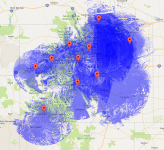I've never heard of a guy leaving his GF at camp to go riding! Where do you camp? (LOL)
All primary means of radio commo is "line of sight" regardless of mode (AM/FM/CW) or frequency. A secondary means of radio contact is by "skip" or "bounce" where a radio signal bounces off of atmospheric conditions and returns back to earth, this type of transmission and receiving a signal works best at lower radio frequencies covered by the Ham frequency bands, but includes GRMS, and the type of antenna becomes critical to direct a signal in the desired direction.
GRMS frequencies are generally operated with omni directional antennas, an example is the "whip" vertical antenna attached to a handheld unit. Search for images of radio antennas used by Hams, most likely the most diverse use, to show directional and omni directional antennas.
So, without going to radio school, just about any radio will do if you're both in Kansas, in the mountains, it doesn't really matter what radio or mode is used, commo will be hit or miss as the signal works or is blocked by terrain features.
Power used to transmit is also critical, generally, the more power used the better the chance the desired contacts will be, but power has several limitations. Radios have limitations, regulations limit power within frequency bands, antennas will also limit power output. That said, good radio operating procedures dictate that no more power than necessary to affect the intended contact should be used. Using too much power can cause problems for the parties attempting to communicate as well as other problems for other operators and, in general, the public. Using too much power can also be illegal.
Satellite phones are an obvious solution but the cost of equipment and usage deter most from casual contacts. I'll mention that Ham's who specialize in the use of low power rigs (QRP) using advanced directional antennas bounce signals off of terrain features and the Moon, to direct signals back to earth, but this can only be accomplished by a stationary operator. There are also Ham communications with satellites but I'm not in that group.
All said and done, I'd suggest you try 2 meter and 6 meter mobile rigs as your camp station and a handheld or small mobile rig on the bike. BTW, was "bike" a motorcycle or a bicycle? A mobile rig will need a 12V battery, the bigger the better, but a motorcycle charging the batter during operation will work, but may not have full power output if the power input is limited.
The range is limited with GRMS radios, they are low power, antennas are limited and they are only reliable within a few miles, often less than 5 miles on a good day. If you ride anything for more than an hour away from the base station, chances are very slim you will make a radio contact. Which is why I suggest 2 and 6 meter Ham, you are allowed to use more power, there are various antenna types that would benefit your operation and you'll have different modes to meet local conditions.
I assume you can pass a simple Ham radio test, it's only a couple of degrees harder than a driving test. If you bear down and get an "Extra" class license, you could use 500 watts of power, a beam antenna on 80 or 160 meters and talk to almost anyplace in the mountains, with a better understanding of radio operations.
If I were you, I'd get her a bike so she could go with you, if she can't or won't, make simple contacts on a schedule that is prearranged and you can make a point of getting to a desirable area to transmit on 2 or 6 meters, then on GRMS but with limited range.

